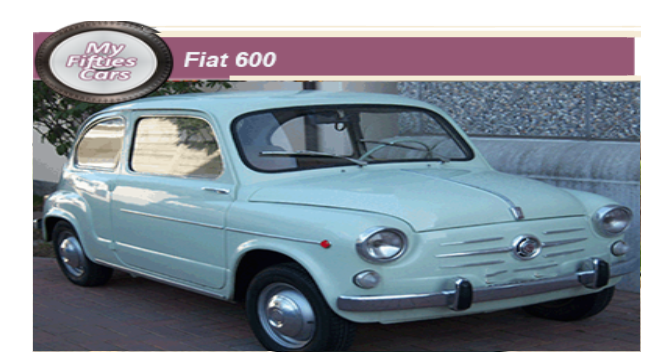 The Fiat 600, or "Seicento" was developed during the early Fifties, first and foremost as a replacement for the 500 Topolino as Italy's version of the "people's car."
The Fiat 600, or "Seicento" was developed during the early Fifties, first and foremost as a replacement for the 500 Topolino as Italy's version of the "people's car."
Designed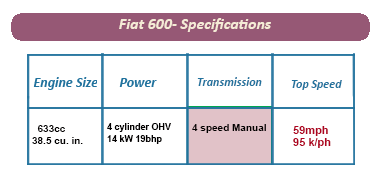 by the famous Dante Giacosa, head of engineering development at Fiat, the 600 was the first small rear-engine, four-passenger car to be produced by the company.
by the famous Dante Giacosa, head of engineering development at Fiat, the 600 was the first small rear-engine, four-passenger car to be produced by the company.
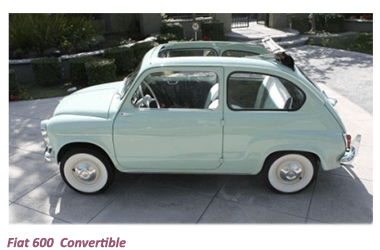 Fiat, well aware of the success of Germany's Volkswagen Beetle and France's Citroen 2CV wanted to ensure that they would have a model that was as good if not better.
Fiat, well aware of the success of Germany's Volkswagen Beetle and France's Citroen 2CV wanted to ensure that they would have a model that was as good if not better.
While there was an element of competition, Fiat's primary goal was to minimise any chance of these models taking a share of the domestic market- which they were succeeding in achieving against the dated 500 Topolino
 The new 600 series made its debut early in 1955.
The new 600 series made its debut early in 1955.
Similar in size to the 500 Topolino which it replaced and the new 500 launched the following year, the 600 carried four passengers in comfort as well as offering ample luggage space both behind the rear seats as well as under the hood to allow for long-distance travel.
![]()
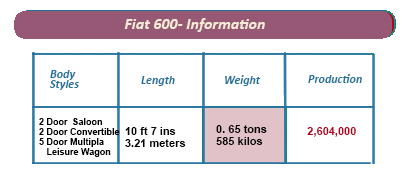 The early version of the Fiat 600 was powered by rear-mounted 633 cc four-cylinder engine capable of producing 20 bhp, although the vehicle's engine capacity was a further twice during its 14-year production run, reaching a maximum of 843 cc.
The early version of the Fiat 600 was powered by rear-mounted 633 cc four-cylinder engine capable of producing 20 bhp, although the vehicle's engine capacity was a further twice during its 14-year production run, reaching a maximum of 843 cc.
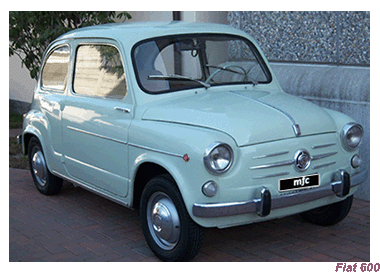 Unlike the Volkswagen Beetle, the Fiat 600 had a water-cooled engine, with an ample cabin heater.
Unlike the Volkswagen Beetle, the Fiat 600 had a water-cooled engine, with an ample cabin heater.
While cooling was generally adequate for the smaller engined version of the 600, as engine power increased, fitting a front-mounted radiator or oil cooler became an absolute necessity to complement the rear-mounted radiator.
 The two-door sedan had rear-hinged doors, a grille made up of three chrome bars, and a trim strip that ran from each headlamp almost to the rear edge of the door.
The two-door sedan had rear-hinged doors, a grille made up of three chrome bars, and a trim strip that ran from each headlamp almost to the rear edge of the door.
A year after its debut, in 1956, a soft-top version was introduced, while during that same year a six-seater " mini-van" variant was also launched- the Fiat 600 Multipla.
Styled more like a minivan than a conventional wagon, the Fiat 600 Multipla,
had a fastback rear end for easy loading. The front of the wagon was adorned by an attractive grille made up of vertical bars.![]()
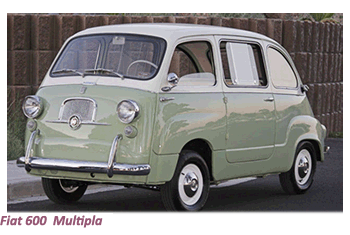 Thanks to its rear-engine, the Multipla's front seats could be shifted forward, directly between the wheels, making the most of the car's small floorplan, with the choice of either a flat load bay, or either one or two bench seats.
Thanks to its rear-engine, the Multipla's front seats could be shifted forward, directly between the wheels, making the most of the car's small floorplan, with the choice of either a flat load bay, or either one or two bench seats.
Because the Multipla was 16 cms ( 7 ins) taller than the saloon or convertible version passengers were able to travel in relative comfort and without the risk of overheating that was fairly standard in the 500 sedan version thanks to the wagon's water-cooled engine.
Although it would go on to be outshone and outsold by its younger " sibling", the Fiat 500, there could be no distracting from the success of the 600.
 With a million cars sold within the first six years that the model was in production, and a total of 2.6 million during its 14-year production run the Fiat 600 was Fiat's best-selling car of the Fifties.
With a million cars sold within the first six years that the model was in production, and a total of 2.6 million during its 14-year production run the Fiat 600 was Fiat's best-selling car of the Fifties.
Many of these sales were notched up in Fiat's rapidly developing and highly valuable markets of South and Central America, earning valuable export income when Italy's economy was showing signs of recovery.
Take me back to the Home Page
EU6


